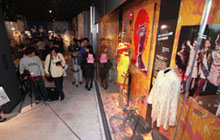IMAGINE THAT:
A John Lennon Revival in Japan
October 19, 2000
|
 |
|
Items of John Lennon's clothing are among the exhibits at a new museum dedicated to the ex-Beatle. (Jiji)
|
The late John Lennon, of Beatles fame, has always had many fans in Japan and is still extremely popular in this country. On October 9, 2000--which would be Lennon's sixtieth birthday if he were still alive--the 1960s icon will receive a wonderful posthumous gift from Japan. That gift is the John Lennon Museum, which opened on that day in the city of Yono, Saitama Prefecture. The museum--dedicated to communicating Lennon's achievements, spirit, and message to the people of the twenty-first century--is the first John Lennon museum in the world to be officially recognized by Lennon's widow, Yoko Ono, who visited the museum just prior to its opening.
Tracing the Life of a Legend
The museum has a total floor area of 3,600 square meters (4,306 square yards) and consists of a theater, an exhibition space divided into nine zones, and a message space. Visitors start by going to the theater to view a film about John Lennon's life. Exhibition zones 1 through 3 contain photos and other memorabilia chronicling Lennon's life from birth through his days with the Beatles, with zones 4 through 9 covering the period from his meeting Yoko Ono to his death. The message space contains Lennon's philosophy of life as embodied in his songs, poems, and utterances.
Adjoining the museum is a cafe built in the image of the Manpei Hotel cafe in the resort town of Karuizawa. Lennon used this hotel as his retreat in Japan for a four-year period beginning in 1976. The museum cafe is also operated by the Manpei Hotel. Most of the objects on display are personal articles on loan to the museum from Ono. The items, which number over 130 in all, include guitars, manuscripts for song lyrics, clothing, and pictures. From his famous round-framed eyeglasses to clothing that he wore in photo shoots for his record sleeves and everyday articles from when he lived in New York, the items in the museum afford a glimpse at both John Lennon, the artist, and John Lennon, the everyday man.
Guitars, Manuscripts, and Memories
Many of the items on display are being shown publicly in Japan for the first time thanks to support from Yoko Ono. John Lennon is famous for his love of Rickenbacker guitars, and one of the guitars in the collection is the first Rickenbacker he ever owned, a Rickenbacker 325 with a natural wood finish. The lyrics for "Woman," the song released just before his death, are also on display. Another item likely to draw attention is a diary kept by Lennon at the age of 11. Yoko found this diary for the first time when she was looking through Lennon's personal belongings for items suitable for the museum. The diary describes the young Lennon's everyday life, includes illustrations, and outlines the concept for a home-produced magazine. This diary, which provides an invaluable glimpse into Lennon's youth, will be displayed for the first time when the museum opens.
Yoko Ono Visits Museum
Prior to the museum's official opening on October 9, 2000, Yoko Ono toured the museum on October 6. At a press conference she said, "I want to present an honest picture of John's stormy life and give each visitor to the museum a feel for his humanity." Asked why the world's first John Lennon museum was opening in Japan, Ono answered, "The fusion of East and West, the ideals John held, his dream of a world without borders. Also because I just thought Japan was the right place."
Twenty years after Lennon's death, Japan's love affair with the star continues unabated. In a TV commercial that began airing in July 2000, Lennon appears with a popular Japanese actor courtesy of computer-graphics technology. The commercial has attracted a lot of attention. In the near future, a solo John Lennon CD will be rereleased, and Japan's first official Beatles web site is going online. It looks like this could be the start of another John Lennon craze.
Back to Main Index
 Copyright (c) 2000 Japan Information Network. Edited by Japan Echo Inc. based on domestic Japanese news sources. Articles presented here are offered for reference purposes and do not necessarily represent the policy or views of the Japanese Government. Copyright (c) 2000 Japan Information Network. Edited by Japan Echo Inc. based on domestic Japanese news sources. Articles presented here are offered for reference purposes and do not necessarily represent the policy or views of the Japanese Government.
|



















